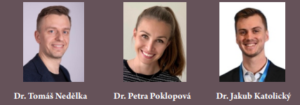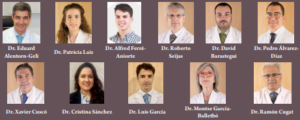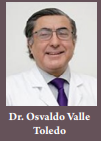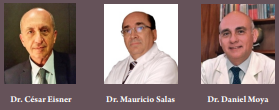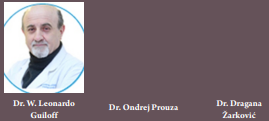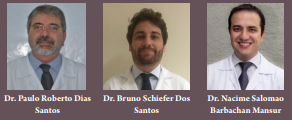Very Low and Low-energetic Extracorporeal Shock Wave Treatment of Spasticity in Children and Adults – A Systematic Review
Systematic Review | Volume 2 | Issue 1 | JRS Jan – Jun 2022 | Page 03-08 | Karsten Knobloch, Henning Lohse-Busch, Andreas Gohritz, Tomas Nedelka
DOI: 10.13107/jrs.2022.v02.i01.33
Author: Karsten Knobloch [1], Henning Lohse-Busch [2], Andreas Gohritz [3], Tomas Nedelk [4,5]
[1] Department of Sports Medicine, SportPraxis Prof. Knobloch, Hannover, Germany.
[2] Zentrum für Bewegungsstörungen, Rheintalklinik Bad Krozingen, Germany.
[3] Department of Neurology, Universitätsspital Basel, Plastische, Rekonstruktive und Ästhetische Chirurgie, Handchirurgie, Suisse.
[4] Department of Neurology, Charles University in Prague, 2nd Faculty of Medicine, Prague, Czech Republic.
[5] Department of Neurology, Czech Technical University, Faculty of Biomedical Engineering, Kladno, Czech Republic.
Address of Correspondence
Prof. Dr. Karsten Knobloch,
SportPraxis Prof. Knobloch, Heiligerstr. 3, D-30159 Hannover, Germany.
E-mail: professor.knobloch@sportpraxis-knobloch.de
Abstract
Introduction: This systemic review aims to assess the modes and treatment parameters of radial and focused extracorporeal shockwave therapy (ESWT) in spasticity based on the technologies and energy levels involved.
Materials and Methods: 1086 patients from 31 randomized-controlled trials (RCT) or cohort studies are included. 300 children were studied in seven studies (3 RCTs) with two radial and four focused electromagnetic ESWT devices and 14 studies with 443 patients using focused ESWT (electrohydraulic 46 patients, electromagnetic 367 patients, and piezoelectric 30 patients).
Results: In electromagnetic focused ESWT 8 RCTs (n = 323 patients) and three cohort studies (n = 44) used either very low-energetic (0.03–0.05 mJ/mm2) with 1500–2000 shots and 4–5 Hz with 3–5 focused sessions, or low-energetic 0.07–0.12 mJ/mm2 with 1500–2000 shots with 4–5 Hz and 1–3 sessions. The 64 children in the five electromagnetic focused trials were treated with very low-energetic 0.03 mJ/mm2, 1500 shots, and three sessions. 17 studies (n = 687) were using radial technologies with 7 RCTs (n = 349) and ten cohort studies (n = 338). Among the 17 trials, four studies (1 RCT, 3 cohort studies) included 236 children treated with either very low-energetic 0.6–1 bar (two trials) or low-energetic 1.5–3 bar with 5–10 Hz. Energy-wise three radial studies were very low-energetic 0.6–1 bar and 14 studies applied low-energetic radial pressures 1.5–3 bar. Notably, the frequency was mainly 4–8 Hz in the radial studies.
Conclusion: Both, radial and focused very low- to low-energetic ESWT improve function and reduce spasticity significantly. Adverse effects were not noted with the applied very low- to low-energetic device parameters neither among children nor in adults.
Keywords: Spasticity, Extracorporeal shock wave therapy, Extracorporeal shockwave therapy, Children.
References:
1. Lohse-Busch H, Kraemer M, Reime U. A pilot investigation into the effects of extracorporeal shock waves on muscular dysfunction in children with spastic movement disorders. Schmerz 1997;11:108-12.
2. Lohse-Busch H, Kraemer M, Reime U. The use of extracorporeal shock wave fronts for treatment of muscle dysfunction of various etiologies: An overview of first results. In: Siebert, Buch , editors. Extracorporeal Shock Waves in Orthopaedics. New York, Tokyo: Springer Verlag Berlin Heidelberg; 1998. p. 215-30.
3. Riedel M, Falland R, Sailer-Kramer B, Lohse-Busch H. Komplexbehandlung mit manueller medizin und physiotherapie bei zerebral bewegungsgestörten kindern. Man Med Osteopath Med 2001;39:72-8.
4. Lohse-Busch H. Extrakorporale Stoßwellen. In: Lohse-Busch H, Riedel M, Graf Baumann T, editors. Das Therapeutische Angebot Für Bewegungsgestörte Kinder. New York: Springer Verlag Berlin Heidelberg; 2000. p. 257-74.
5. Oh JH, Park HD, Han SH, Shim GY, Choi KY. Duration of treatment effect of extracorporeal shock wave on spasticity and subgroup-analysis according to number of shocks and application site: A meta-analysis. Ann Rehabil Med 2019;43:163-77.
6. Lee JY, Kim SN, Lee IS, Jung H, Lee KS, Koh SE. Effects of extracorporeal shock wave therapy on spasticity in patients after brain injury: Ameta-analysis. J Phys Ther Sci 2014;26:1641-7.
7. Cabanas-Valdés R, Calvo-Sanz J, Urrùtia G, Serra-Llobet P, Pérez-Bellmunt A, Germán-Romero A. The effectiveness of extracorporeal shock wave therapy to reduce lower limb spasticity in stroke patients: A systematic review and meta-analysis. Top Stroke Rehabil 2020;27:137-57.
8. Xiang J, Wang W, Jiang W, Qian Q. Effects of extracorporeal shock wave therapy on spasticity in post-stroke patients: Asystematic review and meta-analysis of randomized controlled trials. J Rehabil Med 2018;50:852-9.
9. Dymarek R, Ptaszkowski K, Ptaszkowska L, Kowal M, Sopel M, Taradaj J, et al. Shock waves as a treatment modality for spasticity reduction and recovery improvement in post-stroke adults – Current evidence and qualitative systematic review. Clin Interv Aging 2020;15:9-28.
10. Liu DY, Zhong DL, Li J, Jin RJ. The effectiveness and safety of extracorporeal shock wave therapy (ESWT) on spasticity after upper motor neuron injury: Aprotocol of systematic review and meta-analysis. Medicine (Baltimore) 2020;99:e18932.
11. Corrado B, Di Luise C, Servodio Iammarrone C. Management of muscle spasticity in children with cerebral palsy by means of extracorporeal shockwave therapy: A systematic review of the literature. Dev Neurorehabil 2021;24:1-7.
12. Park DS, Kwon DR, Park GY, Lee MY. Therapeutic effect of extracorporeal shock wave therapy according to treatment session on gastrocnemius muscle spasticity in children with spastic cerebral palsy: A pilot study. Ann Rehabil Med 2015;39:914-21.
13. El-Shamy SM, Eid MA, El-Banna MF. Effect of extracorporeal shock wave therapy on gait pattern in hemiplegic cerebral palsy: A randomized controlled trial. Am J Phys Med Rehabil 2014;93:1065-72.
14. Picelli A, La Marchina E, Gajofatto F, Pontillo A, Vangelista A, Filippini R, et al. Sonographic and clinical effects of botulinum toxin Type A combined with extracorporeal shock wave therapy on spastic muscles of children with cerebral palsy. Dev Neurorehabil 2017;20:160-4.
15. Amelio E, Manganotti P. Effect of shock wave stimulation on hypertonic plantar flexor muscles in patients with cerebral palsy: A placebo-controlled study. J Rehabil Med 2010;42:339-43.
16. Lin Y, Wang G, Wang B. Rehabilitation treatment of spastic cerebral palsy with radial extracorporeal shock wave therapy and rehabilitation therapy. Medicine (Baltimore) 2018;97:e13828.
17. Wang T, Du L, Shan L, Dong H, Feng J, Kiessling MC, et al. A prospective case-control study of radial extracorporeal shock wave therapy for spastic plantar flexor muscles in very young children with cerebral palsy. Medicine (Baltimore) 2016;95:e3649.
18. Mirea A, Onose G, Padure L, Rosulescu E. Extracorporeal shockwave therapy (ESWT) benefits in spastic children with cerebral palsy (CP). J Med Life 2014;7:127-32.
19. Gonkova MI, Ilieva EM, Ferriero G, Chavdarov I. Effect of radial shock wave therapy on muscle spasticity in children with cerebral palsy. Int J Rehabil Res 2013;36:284-90.
20. Santamato A, Micello MF, Panza F, Fortunato F, Logroscino G, Picelli A, et al. Extracorporeal shock wave therapy for the treatment of poststroke plantar-flexor muscles spasticity: A prospective open-label study. Top Stroke Rehabil 2014;21 Suppl 1:S17-24.
21. Sohn MK, Cho KH, Kim YJ, Hwang SL. Spasticity and electrophysiologic changes after extracorporeal shock wave therapy on gastrocnemius. Ann Rehabil Med 2011;35:599-604.
22. Lee CH, Lee SH, Yoo JI, Lee SU. Ultrasonographic evaluation for the effect of extracorporeal shock wave therapy on gastrocnemius muscle spasticity in patients with chronic stroke. PM R 2019;11:363-71.
23. Wu YT, Yu HK, Chen LR, Chang CN, Chen YM, Hu GC. Extracorporeal shock waves versus botulinum toxin type A in the treatment of poststroke upper limb spasticity: A randomized noninferiority trial. Arch Phys Med Rehabil 2018;99:2143-50.
24. Taheri P, Vahdatpour B, Mellat M, Ashtari F, Akbari M. Effect of extracorporeal shock wave therapy on lower limb spasticity in stroke patients. Arch Iran Med 2017;20:338-43.
25. Yoon SH, Shin MK, Choi EJ, Kang HJ. Effective site for the application of extracorporeal shock-wave therapy on spasticity in chronic stroke: Muscle belly or myotendinous junction. Ann Rehabil Med 2017;41:547-55.
26. Santamato A, Notarnicola A, Panza F, Ranieri M, Micello MF, Manganotti P, et al. SBOTE study: Extracorporeal shock wave therapyversus electrical stimulation after botulinum toxin type a injection for post-stroke spasticity – A prospective randomized trial. Ultrasound Med Biol 2013;39:283-91.
27. Manganotti P, Amelio E. Long-term effect of shock wave therapy on upper limb hypertonia in patients affected by stroke. Stroke 2005;36:1967-71.
28. Troncati F, Paci M, Myftari T, Lombardi B. Extracorporeal Shock Wave Therapy reduces upper limb spasticity and improves motricity in patients with chronic hemiplegia: A case series. NeuroRehabilitation 2013;33:399-405.
29. Moon SW, Kim JH, Jung MJ, Son S, Lee JH, Shin H, et al. The effect of extracorporeal shock wave therapy on lower limb spasticity in subacute stroke patients. Ann Rehabil Med 2013;37:461-70.
30. Radinmehr H, Ansari NN, Naghdi S, Tabatabaei A, Moghimi E. Comparison of therapeutic ultrasound and radial shock wave therapy in the treatment of plantar flexor spasticity after stroke: A prospective, single-blind, randomized clinical trial. J Stroke Cerebrovasc Dis 2019;28:1546-54.
31. Marinelli L, Mori L, Solaro C, Uccelli A, Pelosin E, Currà A, et al. Effect of radial shock wave therapy on pain and muscle hypertonia: A double-blind study in patients with multiple sclerosis. Mult Scler 2015;21:622-9.
32. Vidal X, Morral A, Costa L, Tur M. Radial extracorporeal shock wave therapy (rESWT) in the treatment of spasticity in cerebral palsy: A randomized, placebo-controlled clinical trial. NeuroRehabilitation 2011;29:413-9.
33. Li TY, Chang CY, Chou YC, Chen LC, Chu HY, Chiang SL, et al. Effect of radial shock wave therapy on spasticity of the upper limb in patients with chronic stroke: A prospective, randomized, single blind, controlled trial. Medicine (Baltimore) 2016;95:e3544.
34. Wu YT, Chang CN, Chen YM, Hu GC. Comparison of the effect of focused and radial extracorporeal shock waves on spastic equinus in patients with stroke: A randomized controlled trial. Eur J Phys Rehabil Med 2018;54:518-25.
35. Dymarek R, Taradaj J, Rosińczuk J. The effect of radial extracorporeal shock wave stimulation on upper limb spasticity in chronic stroke patients: A single-blind, randomized, placebo-controlled study. Ultrasound Med Biol 2016;42:1862-75.
36. Megna M, Marvulli R, Farì G, Gallo G, Dicuonzo F, Fiore P, et al. Pain and muscles properties modifications after botulinum toxin type A (BTX-A) and radial extracorporeal shock wave (rESWT) combined treatment. Endocr Metab Immune Disord Drug Targets 2019;19:1127-33.
37. Kim YW, Shin JC, Yoon JG, Kim YK, Lee SC. Usefulness of radial extracorporeal shock wave therapy for the spasticity of the subscapularis in patients with stroke: Apilot study. Chin Med J (Engl) 2013;126:4638-43.
38. Sawan S, Abd-Allah F, Hegazy MM, Farrag MA, El-Den NH. Effect of shock wave therapy on ankle plantar flexors spasticity in stroke patients. NeuroRehabilitation 2017;40:115-8.
39. Radinmehr H, Nakhostin Ansari N, Naghdi S, Olyaei G, Tabatabaei A. Effects of one session radial extracorporeal shockwave therapy on post-stroke plantarflexor spasticity: A single-blind clinical trial. Disabil Rehabil 2017;39:483-90.
40. Kim TG, Bae SH, Kim GY, Kim KY. The effects of extracorporeal shock wave therapy on stroke patients with plantar fasciitis. J Phys Ther Sci 2015;27:523-6.
41. Dymarek R, Taradaj J, Rosińczuk J. Extracorporeal shock wave stimulation as alternative treatment modality for wrist and fingers spasticity in poststroke patients: A prospective, open-label, preliminary clinical trial. Evid Based Complement Alternat Med 2016;2016:4648101.
42. Daliri SS, Forogh B, Emami Razavi SZ, Ahadi T, Madjlesi F, Ansari NN. A single blind, clinical trial to investigate the effects of a single session extracorporeal shock wave therapy on wrist flexor spasticity after stroke. NeuroRehabilitation 2015;36:67-72.
43. Amelio E, Manganotti P. Effect of Shock Wave Therapy in Patients Affected by Stroke with Upper Limb Spasticity: Neurophysiologic and Clinical Study. International Federation of Societies for Surgery of the Hand; 2004. p. 535-40.
44. Chaussy C, Brendel W, Schmiedt E. Extracorporeally induced destruction of kidney stones by shock waves. Lancet 1980;2:1265-8.
45. Louwerens JK, Sierevelt IN, Kramer ET, Boonstra R, van den Bekerom MP, van Royen BJ, et al. Comparing ultrasound-guided needling combined with a subacromial corticosteroid injection versus high-energy extracorporeal shockwave therapy for calcific tendinitis of the rotator cuff: A randomized controlled trial. Arthroscopy 2020;36:1823-33.e1.
46. Wang YC, Chen SJ, Huang PJ, Huang HT, Cheng YM, Shih CL. Efficacy of different energy levels used in focused and radial extracorporeal shockwave therapy in the treatment of plantar fasciitis: A meta-analysis of randomized placebo-controlled trials. J Clin Med 2019;8:1497.

| How to Cite this article: Knobloch K, Lohse-Busch H, Gohritz A, Nedelka T | Very Low and Low-energetic Extracorporeal Shock Wave Treatment of Spasticity in Children and Adults–A Systematic Review. | Journal of Regenerative Science | Jan – Jun 2022; 2(1): 03-08. |

